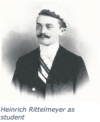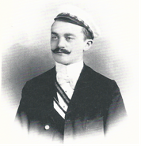Heinrich Rittelmeyer
June 20,1879, Schweinfurt – January 19, 1960, Wiesbaden
From Die Gründer der Christengemeinschaft: Ein Schicksalsnetz, by Rudolf Gädeke
Heinrich Rittelmeyer was born on June 20,1879, in Schweinfurt. His childhood was marked by illness and physical weakness. Only when he grew up did he become stronger and reach a ripe old age. In the weak child, there lived a strong, irascible soul, which repeatedly flared up until the boy attacked an adult with a knife. This experience frightened him so much that he decided to fight the anger with the power of Christ. For years he struggled in prayer until he had conquered his temper. At thirteen, he told his father: “I want to be a pastor.”
 But the confirmand already got into difficulties because he had to profess a faith that would bind him for life. When, in the same year, his brother Friedrich, who was seven years older, traveled home from his intermediate semesters in Berlin and had conversations with the confirmand, further uncertainties arose; years of doubt followed. Yes, Heinrich Rittelmeyer felt himself to be a ‘heretic.’ But he was quite sure: “God is a reality, and the divinity of Christ is a reality because they had brought about the change in my temperament.”
But the confirmand already got into difficulties because he had to profess a faith that would bind him for life. When, in the same year, his brother Friedrich, who was seven years older, traveled home from his intermediate semesters in Berlin and had conversations with the confirmand, further uncertainties arose; years of doubt followed. Yes, Heinrich Rittelmeyer felt himself to be a ‘heretic.’ But he was quite sure: “God is a reality, and the divinity of Christ is a reality because they had brought about the change in my temperament.”
At about eighteen, the student gave a lecture on “Parzival and the Grail.” At twenty-one, he passed his Abitur at the Gymnasium and began studying theology in Erlangen. The course lasted eight semesters, three of which were completed in Berlin. Like his brother, Heinrich Rittelmeyer belonged to the Uttenruchia fraternity. He passed his first examination in 1902 as the third best student and was appointed to the preacher’s seminary in Munich for two years. There he had to preach sermons and give religious instruction in the city and its surroundings.
In 1904, Heinrich Rittelmeyer became a private teacher with the dean in Kitzingen. He gave religious instruction and experienced in a drastic way the untruthfulness with which funeral addresses were given. His difficulties became so great that in 1905 he applied for a leave of absence from the Bavarian church ministry, which was dominated by dogmatism.
From spring to Christmas 1905, he taught at the Protestant Pädagogicum in Godesberg on the Rhine. In addition, he attended lectures in German studies and philosophy in Bonn. The liberal theologian Martin Rade, editor of the journal Die christliche Welt [The Christian World], then found him a position as city vicar in Gotha. There was a free working atmosphere among the very diverse pastors. He was able to pass the Second Theological Examination in 1906 and the philosophical examination at the University of Jena at the end of 1907. Both were not easy to master, as they had to be done in addition to his abundant work at the teacher’s seminary in Gotha. His work as an educator in the subjects of religion, German, and history over eleven years, from 1908 to 1919, filled him completely; it shaped many young people for life.
In Godesberg, Heinrich Rittelmeyer and Änne Kottmann (1884-1967), who had been governess in a German family in Greece for over three years from 1905, became engaged. In April 1908, they celebrated their wedding in Gotha. Two adopted sons grew up in the family. Diverse activities among the educated of the city kept him busy in addition to his teaching activities. He eventually became chairman of the German ‘Sprachverein’ [Language Society]. He now planned to acquire a doctorate in philosophy in Jena. However, he had to abandon this plan when health difficulties made the necessary journeys to the university city (in addition to his work as a teacher) impossible.
About once or twice a year, it was possible to talk personally with the elder brother Friedrich. The latter had become acquainted with anthroposophy in 1910 in Nuremberg through Michael Bauer and had met Rudolf Steiner personally in 1911 in Munich at the last lecture in the series “Wonders of the World, Ordeals of the Soul, Revelations of the Spirit.” He told Heinrich about this afterward. It was not until five years later, in 1916, that Heinrich asked what he should read. The answer was: How to Know Higher Worlds. In spring 1917, Friedrich Rittelmeyer was already working in Berlin when his brother visited him there. A public, so-called Architects’ House Lecture by Rudolf Steiner was announced: “Beyond the Senses and Beyond the Soul” (March 31, 1917, GA 66). Heinrich was the first to hear this lecture. Friedrich then offered him the printed lecture cycles to read, which were still inaccessible to non-members at that time.
Heinrich not only studied them thoroughly on an ongoing basis, but he also excerpted them stenographically, thus acquiring a solid basic knowledge of anthroposophy. Heinrich Rittelmeyer used his understanding of anthroposophy to help a former pupil who had returned from the war with a serious wound and was drawn to spiritualism by questions about the meaning of life. Heinrich intimated to him that anthroposophy was the only sensible thing to do in this situation. To his surprise, this student became a member of the Anthroposophical Society before himself.
Heinrich Rittelmeyer, who had a special relationship with Luther from childhood and had found his personal access to Christ through Lutheranism, gave a lecture in the four hundredth commemorative year of the Reformation, 1917, on Luther’s birthday, which he also had published in print, titled: “Luther, the Prophet of the New Germany.”
In April 1919, Heinrich Rittelmeyer took over the position of vice-principal in the Herford teacher training college. Because of his special interest in Germanic  mythology, he applied to the Westphalian Minister of Culture to go to the area where the memory of Germanic history was alive. His professional responsibilities in Herford became even greater.
mythology, he applied to the Westphalian Minister of Culture to go to the area where the memory of Germanic history was alive. His professional responsibilities in Herford became even greater.
In the field of anthroposophy, he had now gained so much confidence that he was able to become a member of the Society and the branch in Bielefeld in 1920. From 1921 onward, he publicly advocated for Rudolf Steiner in lectures. From such a lecture on June 28, 1921, came the writing: Was will Dr. Rudolf Steiner? [What does Dr. Rudolf Steiner Want?], which appeared in at least six editions.
The years 1920 and 1921 also enabled him to have two conversations with Rudolf Steiner, which mainly dealt with meditation. In the meantime, Heinrich Rittelmeyer had changed from a person who prayed intensively from his youth, and indeed prayed for many other people throughout his life, to a person who now also meditated energetically. He received many impressions, but he did not like to talk about them. Out of Heinrich Rittelmeyer’s conversations with Rudolf Steiner it is important to note that Steiner’s indication that Luther and Raphael were in Rome at the same time but did not meet in person remained with him for the rest of his life.
He was a particularly quiet and, in a way, sober person in addition to being a teacher.
Now the time was approaching when he learned of the preparations for the founding of The Christian Community. In the spring of 1922, he had decided to place his life in their service, and so he was ordained priest by his brother on September 16, 1922, in Dornach. At the age of forty-three, he was already one of the older ones.
Without his family, who remained in Herford, he founded the three congregations in Karlsruhe, Mannheim, and Heidelberg in the twenty-five months from October 1922 to November 1924.
After working in the twin congregations of Mannheim-Heidelberg and Herford-Bielefeld, he continued his work in Wiesbaden Mainz starting in 1935.
After the banning of The Christian Community on June 9, 1941, Heinrich Rittelmeyer was arrested together with Fritz Blattmann by the Gestapo in Darmstadt on June 12. SS men indiscriminately dragged laundry baskets full of books and manuscripts (even the bride’s letters) from the flat; under threat of punishment, the parents were forbidden to inform their son in the field of this action. After his release from prison on August 16, 1941, friends found him a job at the Erdal-Werke in Mainz with the task of writing about the historical development of the shoe and its care. After the total bombing in October 1944, Heinrich Rittelmeyer lived with friends in the Taunus until June 1945. Then, after the re-establishment of the Wiesbaden congregation (1945), he worked there until his death on January 19, 1960. After twenty-two years, he followed his brother, under whose importance he had suffered throughout his life, into the spiritual world.
An important teacher of his students, a praying pastor who accompanied all the people of his congregation daily in his consciousness, he also included the deceased in his prayers daily with the help of a little book in which he had entered hundreds of names. He was a humble, faithful minister in the performance of the sacraments, a courageous advocate of anthroposophy, and a quiet meditator: that was Heinrich Rittelmeyer. He rightly wore the ring of the archpriest (see also August Pauli and Rudolf von Koschützki).



Leave a Reply
Want to join the discussion?Feel free to contribute!